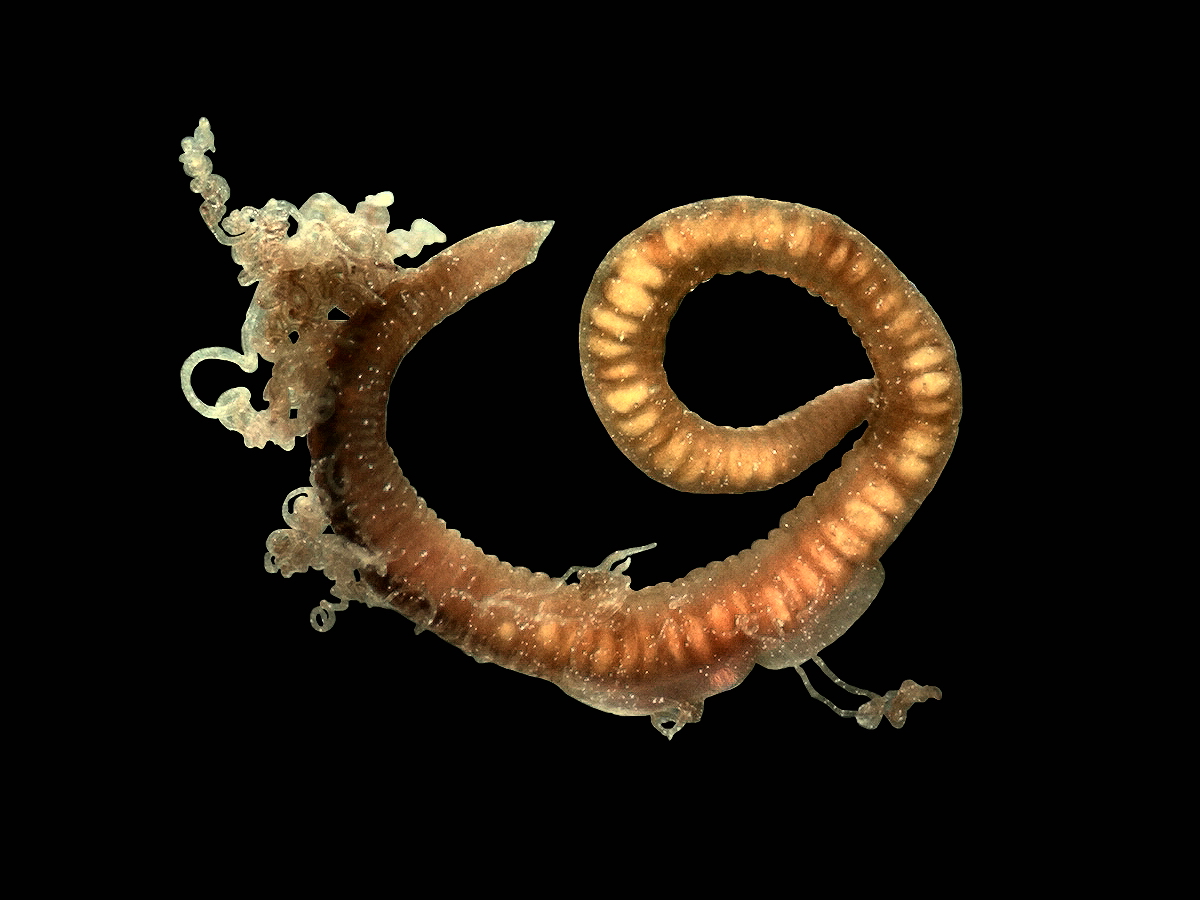- Terebellida
__NOTOC__Taxobox
name = Terebellida

image_width = 240px
image_caption = "Chaetozone setosa " (Cirratulidae ), a burrowing terebellid
regnum =Animal ia
phylum =Annelida
classis =Polychaeta
subclassis =Palpata
ordo =Canalipalpata
subordo = Terebellida
subdivision_ranks = Families
subdivision = Several, see textTerebellida (sometimes called Terebellomorpha) make up a
suborder of the "bristle worm" class (Polychaeta ). Together with theSabellida , theSpionida and a some enigmatic families of unclear relations (e.g. theSaccocirridae ), they make up the orderCanalipalpata , one of the three mainclade s of polychaetesRouse & Fauchald (1998)] .Almost all are (like polychaetes in general)
marine organism s. Most are smallishdeposit feeder s which frequently live in small tubes they build from mud or similar substrate, or burrow in the sand. Theircentral nervous system displays characteristicapomorph ies.A well-known member is the
Pompeii worm ("Alvinella pompejana"), analvinellid . It is the most heat-tolerant complex lifeform known on Earth. Found onhydrothermal vents deep in thePacific Ocean , it thrives when its body temperature is 50°C (122°F). This is near the technical limit foreukaryotes , whosemitochondria desintegrate at about 55°C (131°F).ystematics
There is little consensus on the number of families. Some treatments accept as little as five [E.g. Fauchald, (1977), Holthe (2001)] , while other authors list over a dozen. Here, the more inclusive view of the Terebellida is followed, based on a major review of polychaete systematics.
Cladistic studies have hitherto only analyzed a rather small proportion of polychaetes; hence it may be that some of the families today included in Terebellida by most authors will eventually be again recognized to belong elsewhere.*
Acrocirridae (sometimes placed inSpionida )
*Alvinellidae – alvinellids
*Ampharetidae
*Cirratulidae (sometimes placed in Spionida)
*Ctenodrilidae (sometimes own suborder Ctenodrilida)
*Fauveliopsidae (sometimes own suborder Fauveliopsida)
*Flabelligeridae (sometimes suborder Flabelligerida)
*Flotidae (sometimes included in Flabelligeridae)
*Pectinariidae – trumpet worms, ice cream cone worms, pectinariids
*Poeobiidae (sometimes own suborder Poeobiida or included in Flabelligerida)
*Sternaspidae (sometimes own suborder Sternaspida)
*Terebellidae – spaghetti worms, terebellids
*Trichobranchidae Fossil record
Although polychaetes, like all small animals lacking a firm
skeleton , do notfossil ize well, s number of prehistoric bristle worms have been described. Several of these are placed in the Terebellida, though often only tentatively so owing to the continuing uncertainties about polychaetephylogeny .However, as the terebellid habit of constructing characteristic tubes to live in seems quite ancient, and such structures are occasionally found in conservation
lagerstätte n. Polychaete remains associated with suchichnofossil s can therefore be quite certainly be allocated to the Terebellida.Prehistoric polychaete genera presumed to be Terebellida include:
* "Arthrophycus " Hall, 1852
* "Cryptosiphon " Prantl, 1948
* "Granularia " Pomel, 1849
* "Harlania " Goppert, 1852
* "Lepidenteron " Fritsch, 1878
* "Paraterebella " Howell, 1955 (= "Terebellopsis" Howell, 1953)
* "Proterebella " Howell, 1953
* "Psammosiphon " Vine, 1882
* "Scalarituba " Weller, 1899
* "Scolecoderma " Salter, 1855
* "Terebellites " Howell, 1943
* "Terebelloides " Desio, 1940
* "Terebellolites " Desio, 1940
* "Terebellopsis " Leymerie, 1844 (see also "Paraterebella")Footnotes
References
* (1977): The polychaete worms, definitions and keys to the orders, families and genera. "Natural History Museum of Los Angeles County Science Series" 28: 1-188.
* (2001): [http://folk.ntnu.no/vmzothol/TERHP.htm The Polychaeta Terebellida homepage] . Version of 21001-FEB-09. Retrieved 2008-Mar-21.
* (1998): Recent views on the status, delineation, and classification of the Annelida. "Am. Zool." 38(6): 953-964. doi|10.1093/icb/38.6.953 [http://icb.oxfordjournals.org/cgi/reprint/38/6/953.pdf PDF fulltext]
Wikimedia Foundation. 2010.
